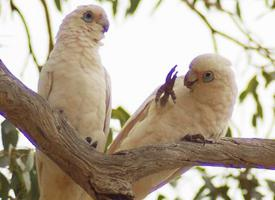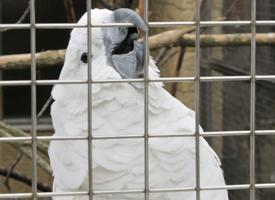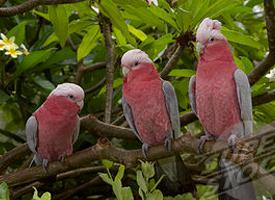
Poids et mesures
| Longueur | de 36 à 39 cm |
|---|
Description de l'animal
The Little Corella (Cacatua sanguinea) is a captivating bird species belonging to the cockatoo family, native to Australia and some parts of New Guinea. This bird is distinguished by its predominantly white plumage, which covers most of its body, complemented by subtle hints of pink on the face and throat, which can be more pronounced in some individuals. A distinctive feature of the Little Corella is the short crest on its head, which, unlike those of more flamboyant cockatoos, is less pronounced and can be raised or lowered. The crest, along with the bird's expressive eyes, adds to its range of charismatic expressions.Measuring between 36 to 39 centimeters in length and weighing approximately 500 to 570 grams, the Little Corella is a medium-sized bird with a robust build. Its wings are broad and powerful, enabling it to fly long distances with ease. The bird's beak is short but strong, perfectly adapted for cracking open nuts and seeds, which constitute a significant part of its diet. The beak's color, a striking contrast to its white plumage, ranges from pale to deep pink. Its legs are relatively short, with strong, zygodactyl feet that are adept at grasping and manipulating objects, aiding in feeding and climbing.
The Little Corella is a highly social and gregarious bird, often seen in large flocks that can number in the hundreds or even thousands. These flocks are a sight to behold, filling the sky with a cacophony of squawks as they move between feeding and roosting sites. Their social structure is complex, with strong bonds formed between pairs and within larger groups. This social nature extends to their interactions with humans, with whom they can form strong attachments when kept as pets.
In the wild, the Little Corella's diet is varied, consisting of seeds, nuts, fruits, and occasionally insects and their larvae. They are known to forage on the ground, in trees, and in agricultural fields, where they can become a nuisance to farmers by feeding on cultivated crops. Despite this, they play a vital role in their ecosystem, aiding in the dispersal of seeds and the control of insect populations.
Breeding season for the Little Corella varies depending on their geographical location but generally occurs during the spring and early summer. They are monogamous birds, forming strong pair bonds that often last for life. Nests are typically made in hollows of trees, where the female lays a clutch of 2 to 4 eggs. Both parents share the responsibility of incubating the eggs and feeding the chicks once they hatch. The young are altricial, meaning they are born relatively undeveloped and depend entirely on their parents for warmth and nourishment. After several weeks, the fledglings leave the nest, though they often remain with their family group for some time before becoming fully independent.
Despite facing threats from habitat loss and competition for nesting sites with other species, the Little Corella has adapted well to human-altered landscapes and is not currently considered endangered. Their adaptability, coupled with their charismatic nature and intelligence, has made the Little Corella a beloved bird both in the wild and as a companion animal.
Carte de répartition

Animaux similaires
Nouvelles photos d'animaux
Top 10 des animaux
- Dolphin gull (Leucophaeus scoresbii)
- Diana monkey (Cercopithecus diana)
- Moustached guenon (Cercopithecus cephus)
- Galápagos tortoise (Geochelone nigra complex)
- Russian tortoise (Testudo horsfieldii)
- Stone loach (Barbatula barbatula)
- Japanese macaque (Macaca fuscata)
- Common flying dragon (Draco volans)
- Greek tortoise (Testudo graeca)
- Vendace (Coregonus albula)


